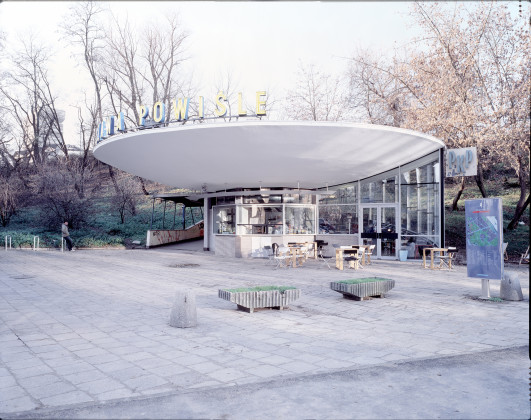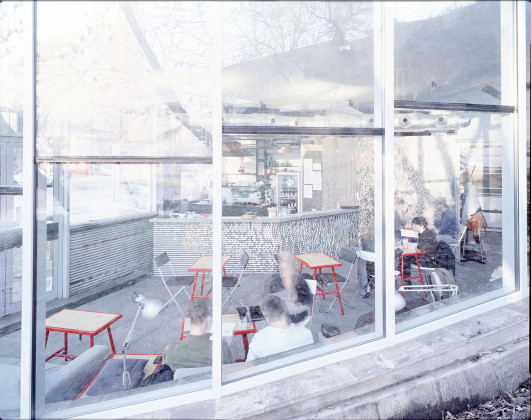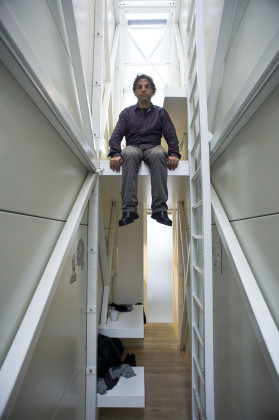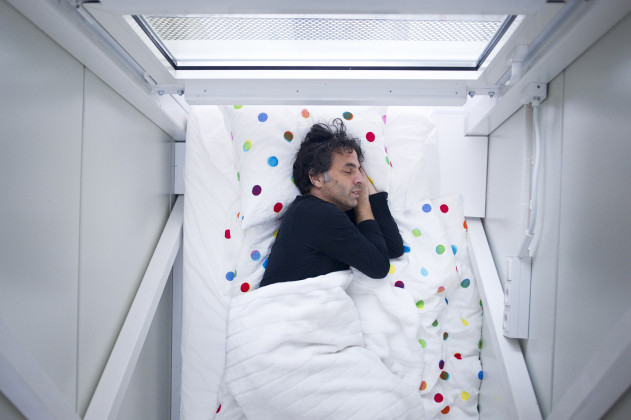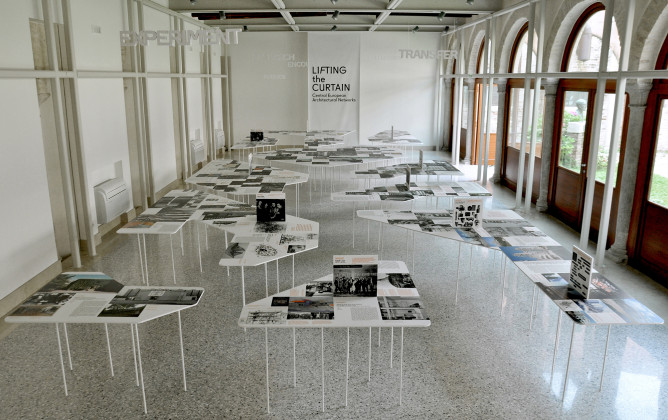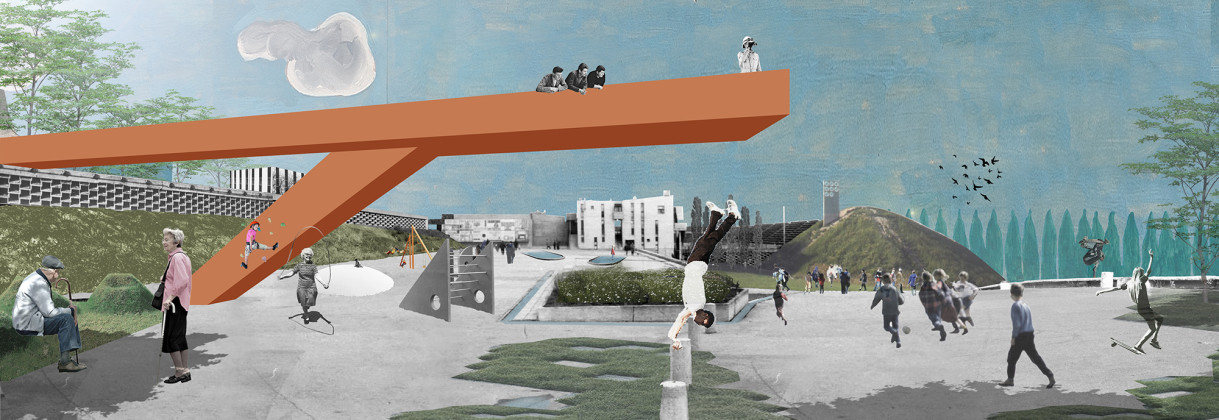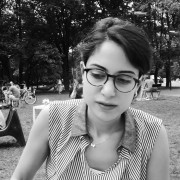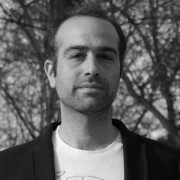Architecture as a Tool of Negotiation between Past and Future
Centrala adopts a design approach that considers the past as a source of overlooked yet valuable expressions that are available to be used in the progressive ways of designing
With projects engaging in urban activism, Centrala adopts a design approach that considers the past as a source of overlooked yet valuable expressions that are available to be used in the progressive ways of designing. Can Sucuoğlu and Elif Ensari talk to Malgorzata Kuciewicz, Simone de Lacobis and Jakub Szczęsny from Centrala for XXI, looking into their architectural approach shaped under the political circumstances of past and today, as well as the changing expectations in society in Poland.
Your office seems to operate on three different scales: the public scale, the private houses, and the installations. How do you see the relationship between these three scales? How does it affect the inner dynamics of the office? Do you define it as a business model, or is it result of a demand?
Malgorzata Kuciewicz: I think there are three categories - public, private and social. Installations are a useful tool to create social spaces, and dialogues around [social spaces]. This social space is the one in which we negotiate the most. The social space is always a negotiation between the social life and the public space, and considering that public spaces in Poland have diminished significantly, we often reach for this tool.
Simone De lacobis: Our clients are mostly public. We work with public institutions and collective clients like small communities, or NGOs—both of which play a major role here.
Jakub Szczęsny: I am also starting a new office called SZCZ for private clients, which will be centered on commercial architecture. The name derives from my beautiful surname, you can check out my website: www.szcz.com.pl
So you divided the commercial [work] and the public work into two different practices.
JS: Yes, I have three sons, and to be able to provide them with an education, I cannot be a total hippie anymore; so I have become more interested in the private sector. We were always very interested in what it means to provide a habitat for people, and [in] how people inhabit these places. We’re examining how we circumvent the stereotypical modernistic thinking about the living environment that individuals or small groups of people occupy. This has become the subject of the deep standardization done in the modernistic-hygienistic spirit.
We all know the power of Neufert. One could actually consider Neufert as the most influential architect in Poland—thanks to his manuals. But what derives from our interest in habitation is that we are dealing with very diverse clients with really different approaches; most of them being kind of freaks—they have different levels of income, but a high level of self-consciousness. Given that we know how to ask the right questions, what can come as a result are nodes of life that differ greatly from the established bourgeois tradition.
Suddenly in Poland after [the year of] 1989 we had reached the moment where people wanted—sometimes in very stupid ways—to express themselves. The freedom of expression was newly possible; modes for this expression were available [since] we were freshly exposed to Western TV series. People started to act like children in fog, looking for different ways of expressing themselves. And we, as architects, could either deepen the status quo, perpetuate mainstream lifestyles, and be appreciated by the biggest client demographic by just repeating bourgeois ideas; or, as we do in Centrala, start building for new lifestyles.
For now, I am working for a client from Tennessee, on a house that is a place of intellectual living in the hills, surrounded by nature. A relevant part of the brief is the client’s desire of isolation for writing, as he is a professor at a university; and alongside that, because he is an orgiastic man, part of the brief is to provide a space for sex for six people.
It seems like although there has been a very long tradition of design in Poland, especially [of] very famous graphic design, lately we hear a lot more about contemporary design [from Poland]. It seems like there is a new demand for architecture, or there are new clients. With the stabilizing economy and EU bringing in the money, Poland is becoming a little bit richer; yet on the other hand there is a very strong right wing current gaining power in the country. There is even a foreign minister claiming “biking and hippies are not Polish common values.” How do you see such economic and political changes affecting your practice?
MK: It is a very good time to make critical art. The artists are mobilized now. A competition for the Polish Pavilion is being held this year at the Venice Biennale of Art, and I know most of the entries will be very critical of the situation. The art world in Poland is certain that now is the last season before the unknown, because the governments’ policy is essentially to manipulate the art scene and the collective memory. For example, the Polish Institute of Adam Mickiewicz will most likely have to change the way it will present Poland abroad.
JS: ...into promoting folk dances and all that stuff. The Turkish policy may be pretty much the same.
MK: We designed the Polish pavilion for the XXI International Exhibition at the Triennale di Milano in 2016. The message of that exhibition, prepared by Magdalena Kochanowska, is about the primeval values of design itself. It is about beauty and pragmatism. Nothing else. Simple or even banal at the beginning, but upon entering the exhibition, you'll find that it is quite a good curatorial recipe. The exhibition features exclusively products currently available on the market; all the objects in display were produced last year. We crafted a “Spatial Relief”, which refers to the bold, mid-century Polish exhibition design; it’s a three dimensional display tool for exhibits.
JS: But the new policies haven’t influenced our work yet. We are still in the positive shadow of money spending [which was] cast during a more the liberal rule; before the right wing craziness started.
You can look at Hungary as an example because they were subjected to this shadow of right wing politics that hindered modern expression for a long time. There was an interesting interview by a Polish curator from CSW with the group called Little Warsaw (Mała Warszawa), who [consists of] two artists from Budapest. They said that after fifteen years of right wing rule, the right wing virtually killed all modern art institutions; and they exist now as skeletons, only for touristic purpose. There is almost no significant public sector left when it comes to modern expression. So everything there happens in small galleries, groups of friends; basically, it went underground.
To explain this, I can quote Milan Kundera, from his book “the Curtain”, where he talks about the fatality of Central Europe when these countries create a situation in which they fall, over some time, into what he calls auto-provincionalization. When you think about Turkey, there is the European part, and you have Anatolia, and suddenly the Anatolian lifestyle with Islamism and all is coming to power. Erdoğan’s power comes from Anatolia. So this is what is happening in Central Europe in different ways, which means that [their] leaders are sort of Erdoğan. They are coming from local Anatolia, from the provinces.
The minister that you were referring to is Witold Waszczykowski, the Minister of Foreign Affairs; you can see that every example of the auto-provincionalization tendency in him. Not only [in] what he is saying, but also in the representation of himself; in the mustache for example, [which is] the traditional style of the land owner.
Maybe for the next few questions here I would like to talk about nicer things. I would like to talk about your project for the Powisle Train Station. A former station and a beautiful constructive structure which you have turned into a very popular open air, bar-event space; my favorite place in Warsaw.
JS: It was the lower pavilion of the Polish National Railways, with a ticket counter.
MK: In between 1954-76, Arseniusz Romanowicz and Piotr Szymaniak, were in charge of designing all train stations in Warsaw. Since 2002, as architects, we have been trying to influence Warsaw's perceptual [image], by popularizing the overlooked buildings and urban structures. For the last seven years or more, we have contributed to the debate on progressive ways of preserving Modern architecture. The regeneration of Powisle's lower pavilion marked the moment when post-war modernist architecture in Warsaw started to be widely appreciated. Quickly it became common sense; cups are being produced, t-shirts, posters of Powisle - it has developed into a lifestyle trademark, a commodity, a brand.
After this commission we moved away from single buildings and started to think about larger systems; policies regarding groups of buildings, artificial landscapes and urban infrastructures. We wanted to bring this debate to the table of the Museum of Modern Art. There is a need to talk about materiality and the originality of modern architectural substance. It would be ideal to gather a physical catalog of the Polish modernistic lexicon—the visual language.
This particular language has been neglected, [and] dismissed as part of a forgettable past, with every single renovation or adaptation. As a society, we lose a significant part of the vocabulary of these buildings. Back then, architects made use of a very specific vernacular because of a lack of materials and a lack of technology; they came up with a few solutions which were unique to Poland. Recurring materials, [and] details which are now disappearing quickly due to unfaithful renovations or demolitions. As a reaction what we did as architects was to start collecting parts of these buildings. With every destruction in the city, we gathered some parts. Our office is basically a repository. We are thinking about putting them into use.
The real, physical parts of the buildings?
JS: Yes. At the time in Western Europe, many new materials and technologies were being developed. We could not import them because they were too expensive. But in an amateur way, these were reproduced based on photographs. Inspired by all the German architecture such as Baumeister, they thought “wow!”—and started reproducing.
Maybe we can continue with the Archipelago project. It is located in a similar context; in between two housing blocks that were built in the communist era...
MK: Currently, there is a huge initiative in Poland for creating projects based on social space, and this is one example of our participatory process.
Our next project is also about urban sport. We are trying to investigate this because it sounded like a nostalgic approach towards materiality of buildings, since nobody was reusing the parts of the demolished buildings. So now we are working with Skwer Sportów Miejskich Foundation, and a developer, who is responsible for refurbishing the banks of the Vistula River in Warsaw. For example, they have beautiful concrete elements that we can use for skaters. We are thinking about these because Warsaw was built from World War II rubble, so we decided that if they would share with us their knowledge about the deconstruction, we could compose a new design process around it where we could enjoy designing with the best parts.
I am considering the Powisle project as you trying to find a way to make peace with the past. One is in an abandoned station with a communist, or let’s say, a constructivist look; and the other one is housing blocks that always have a lot of social problems. You have invented a witty way for dealing with these difficult topics in both projects.
JS: You have to remember that from its conception, Centrala has not blindly appreciated the past, but [instead] has developed an approach in which the past is not removed. Whatever happened before 1989—we don’t cut it away and say “now is a new era”. Our aim was to look for motives that were most significant or unknown, yet valuable. That’s why we have been working with forgotten and misused modernist expression in buildings which were not protected by legal conservation after the war. In Poland, the legal conservation of modernist buildings was only for the buildings built before 1939. And we are part of a larger movement—there are many people who want to make the buildings which built after 1939 valuable again, and to make it a part of the identity of Poland by not reading them only as communist structures. These buildings were, in a way, an expression of an opposition to communism. Many of them were constructed as a way to reconnect us with what was happening abroad, in the Western world. During communism, most of the population wanted to feel Western, not Eastern. East was associated with Russia and with a certain set of values that we didn’t identify with.
MK: Since 2013 we are involved in promoting the architectural visionaries from the Socialistic period. For instance we designed Oskar Hansen's travelling exhibition (who designed The Polish Pavilion at the Izmir International Fair in 1955) for the Warsaw's Museum of Modern Art. The exhibition has been shown at MACBA in Barcelona, Serralves Foundation in Porto, and is currently at Yale School of Architecture. Hansen was the first visionary architect whose ideas and methodology we tried to re-interpret.
In November we will be opening an exhibition about Jacek Damięcki, the last living Polish modernist visionary. In collaboration with him, we will create a macro installation and reveal some of his unrealized projects, which were visions, but are still very fresh and everlasting.
SD: To follow what Jakub mentioned. We are engaged in establishing continuity, a rebirth, after cycles. 1989, World War II were all breaks in these cycles.
Basically, we read history like a continuous line and we are analyzing the masters from the past because we are learning from them. Their inspirations and values are still actual; [they are] a very contemporary way of thinking about social space. Especially Damienski's installations in public spaces. There are a lot of ideas and ideologies that can still be valuable.
Even re-editions of furniture from the 1960s—that time gave birth to many interesting ideals that were hindered by the limitations of the Polish industry of the time. Suddenly, 50 years later, these designs can reappear and be mass produced because the times have changed.
I want to move on to the scale of Warsaw. My first personal impression from Warsaw, from about 6-7 years ago, was that it was an unwelcoming city; but visiting there again a few years ago, it seemed like the lifestyle is changing towards a more active and visible social life. I know you are very interested in public space. What do you think is encouraging this change, or do you actually see a change as such? Is it the NGOs, the local governments or people taking the initiative themselves? What has changed in such a short time? Is [it] the image of Warsaw [changing] or the Warsawian is changing as well?
JS: There are two very important things. EU and EU money. 2004 was the year when EU money started to flow in, and the first bicycle path appeared in the city that same year. Parallel to the effort of entering the EU since 1997, Poland has established a long lasting policy of so called self-governance reform, which meant that the money, to a bigger extend, had to be distributed locally. We don’t follow the federal government paradigm that we know from Germany, for example – this is a decentralized system. Local governments and local inhabitants decide on what they want to spend the money on. The next step has been the participatory projects. The budgets are not very big but it is good political PR, so it feeds the mechanisms that enable groups of citizens to apply their ideas -with municipalities- on how to make their own reality better. Cycling paths, benches, small parks etc. The micro scale things improve daily life.
Do you think these are lasting policies? Do you think it will last, or do you think right wing policies will affect this badly?
JS: From the social politics point of view, I think things are going to get complicated. In Poland, right wing got to the power basically as something that could be described as fascism or national socialism. National socialist means that it uses nationalism as a symbolical realm of references to unite the citizens of a certain category. The second aspect is that they are socialists. Suddenly, a right wing party is using the strategies of the socialist left wing parties by having a very strong socialist policy of spending money on social amenities.
Their way of thinking is authoritarian. So they would do their best to stir the country in a Putinistic, Erdoganistic way. But they would pretend it is a democracy the same way any contemporary satrap does by maintaining different mechanisms that look like self-governance.
I would like to ask you about the exhibition you did in the Venice Biennale, “Lifting the Curtain”, which was based on the Central European Network. Do you feel part of a grand network, connected with your neighbors, and if you do, what do you think this connection is based on? Is it a similar political or economic landscape? Is it some kind of a shared history or aesthetic understanding? Do you see a future for such a network?
MK: The exhibition is still traveling. There are even new partners in that constellation. We hope it would be shown in Poland next year. Somehow it worked as an idea; it pooled a lot of knowledge. But at the end of the day, we are not scholars. This network works much better for the scholars because they started to invite each other to different activities. Being attached to a subject for 10 years is too much for us. The aforementioned Damiecki's show in the National Gallery is the most direct outcome of the Venice experience. Now that we have paid our dues to the past we are ready to dive into the exploration of the future with groups like Monnik.
So it was more the past that connected you with the Central European Network; and then it is the future that connected you with Monnik.
MK: Yes. In Warsaw, we did a publication together. We contributed with the history of housing blocks. This is relevant because two thirds of all buildings in Warsaw are these kinds of blocks. But there are different typologies, different experiments, and ideas. We blurred these definitions genealogically in the publication.
But they diagnosed us with the language of oppression. Whichever time period we are talking about—Russians, Soviets, Nazis—we here in Warsaw have operated with the language of oppression. Ole Bauman gave us a second diagnosis: “the pessimism of the mind and optimism of the will.”
Now we are developing with them the idea called “Thick Space”, which is about how architecture can contribute to the production of biotopes. With this project, we will grow places where you can experience “Thick Space.”
SD: But the Central European Network is an ambitious project that has somehow partially failed. At the beginning there was a lot of enthusiasm about participating in the Venice Biennale together. The idea of collecting all these hidden, beautiful projects from Central Europe that nobody knew about, which drove the history of modernity with a Central European perspective, was exciting. At the beginning we even wanted to create a Central European Pavilion which would be transnational. We felt that the Venice Biennale’s national pavilions were outdated. We managed to set up a collateral event at the end. It was quite a struggle; I have to say. The business side of the Venice Biennale hit us in the face. By investigating the historical networks, we eventually established ourselves a new network.
I would like to ask about the Keret House. It brought you a lot of recognition. How did you deal with these extreme conditions or more interestingly, how could it be that the site was not used? Who did it belong to, and how did it come to life?
JS: Everything started with my interest in restrictions, which was first expressed in one of the issues in the Synchronicity Festival, which we organized with the Bęc Zmiana foundation. It was called “reduction.” The thesis revolved around the question: “What can we do in order not to become slaves of the mechanisms of turning into a western capitalistic society?” This mechanism being over-banking our lives with banking products; with loans, specifically. This is a big issue in Poland; people are buried deep in debt. In order not to do this, we should limit our expectations and we should start thinking in a more rational way about how we live in apartments. Although the price of an apartment is based on different things—surface area being the most decisive factor. We can produce more efficiently designed apartments which are smaller, like [they were] in communist times. People were very skilled in this at the time. Since 1990's, we began living in giant apartments and houses which made people become slaves of these huge loans. So this was the thesis of the festival.
I grew up in a small, socialist apartment in Ursynów , which was the biggest experimental district, with 40.000 inhabitants, built in 70-80s (Kieslowski's Dekalog was filmed in Ursynów). For the first time in Polish history, not only architects, but also landscape designers, sociologists and physiologist were involved in the production of space. There is a new book that came out in Polish which will be translated as “Blocks in the Sun” exploring the entire social experiment.
The funny thing is, in Warsaw, you can clearly see how much time is necessary to go from the modernist vision to the fulfillment of it. It took 40 years for the space to become what it was intended to be. For the trees to grow and for the subway to be built; for the local commercial infrastructure and the social infrastructure to fill the spaces between the blocks. It is now a highly livable place and it is one of the most popular places for the middle class to settle. Actually there is no other new residential development in Warsaw that can be compared to it. The quality of life there [is good], despite being confined. Even though the limitations of the prefabricated buildings are many, [the buildings] are incomparably good to live in.
I have one last question. What do you see for the future of Centrala, your practice, and for you, as individual designers? You have established yourselves not very long ago and done quite a lot. How do you think [the practice] will evolve in the future?
MK: We diverge; because Jakub is opening his own office (szcz.pl), and we are building up bigger collaborative networks. We still collaborate with different offices, as well on different levels. It seems it is about personal interests and needs. All those processes that we activated, the outcomes come about after 5 to 7 years. So only now we are harvesting the fruits.
JS: There is another initiative of mine about the reduction of space to create houses that are available at a low price (Simple House). Because we still do not have any residential policies in Poland, the only way to approach the subject of availability of housing is through the private sector, which has doubled in the last year. When we started working with the private sector, our approach was very refreshing to them.
SD: To quote Damiecki “The universe is not something that is so very distant from us, because as we sit here, its fragments rest in the palms of our hands”.
Related Content:
-
Seeds of Awareness
In the guidance of Michael Leung, this interview looks into a collective movement that flourishes at a street stall in Hong Kong as a reaction to the current development plans
-

Modern Approaches
-
Practice of Practices
How can we generate solutions in real life to our most prominent urban issues like sustainability, mobility, equality, etc.?
-
Handmade Inspirations
The world agenda full of crises makes it necessary for architectural practice to take a new look at the built and natural environment, and to develop new perspectives
-
Educational Possibilities in Urban Refurbishment
Critical Concrete, concentrating on the refurbishment of socially relevant spaces of Porto suburbs, shows us how to be super cool by being super normal
-
Reframing the Social
Hülya Ertaş talked to Florian Koehl on the social agenda of architects today and the alternative ways of realizing projects within the existing social and economical framework
-

City Courtyard Recieves Second Life
-
Unlocking Architecture’s Potential to Invest in Future
Engin Ayaz and Christian Benimana of MASS discuss how architecture should function, as well as looking into the facts of social design in Africa
 25.10.2016
25.10.2016



